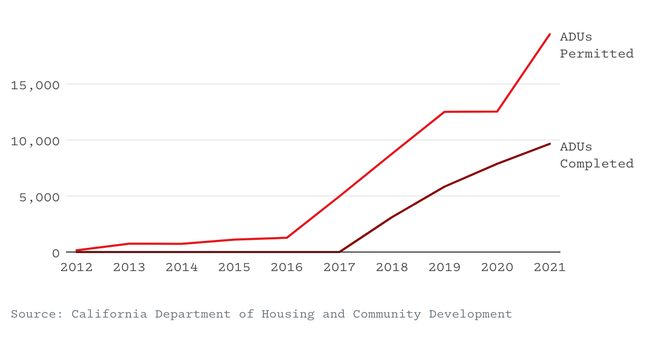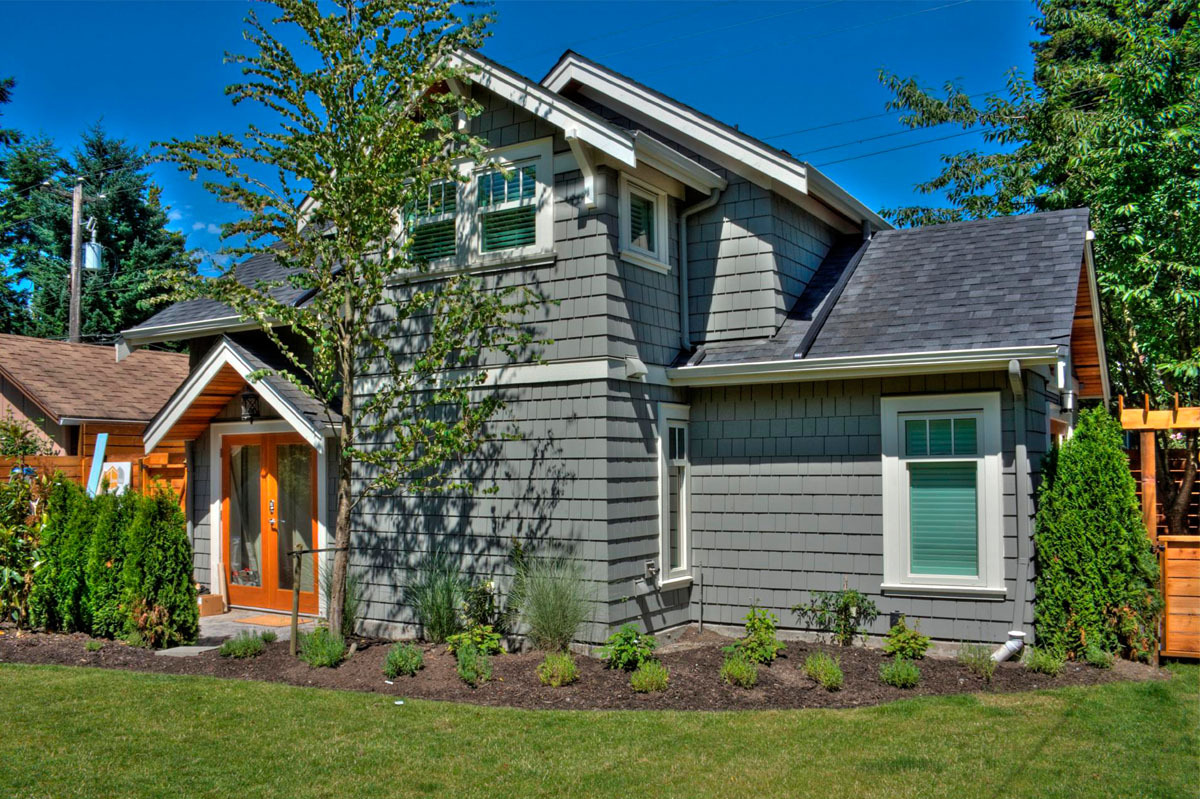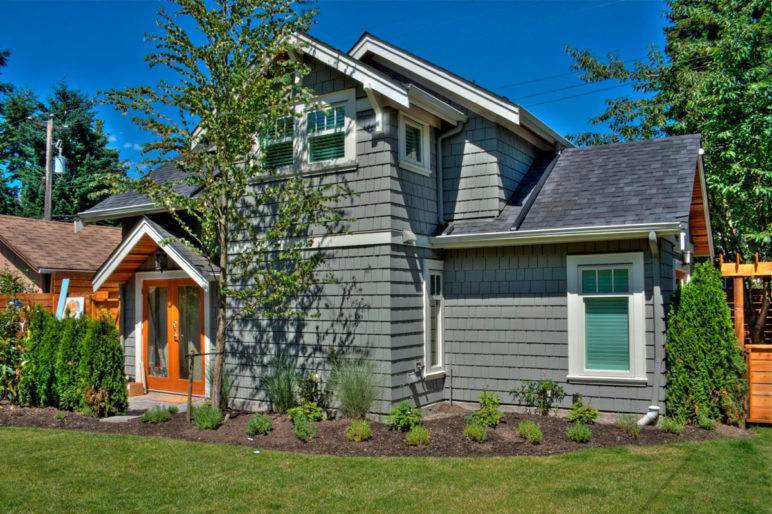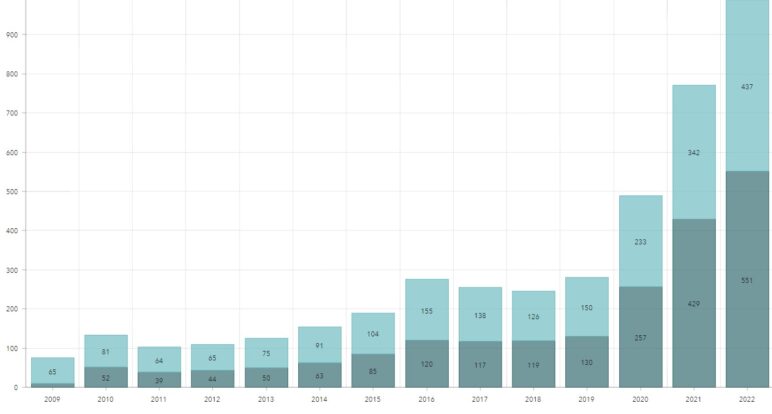UPDATE 05/08/23: HB 1337 passed and was signed into law by Governor Jay Inslee on May 8! The House concurred on Senate amendments on April 14, the Speaker signed on April 17, and the President of the Senate, Lieutenant Governor Denny Heck, signed on April 18.
UPDATE 04/06/23: HB 1337 passed the Senate on a bipartisan vote of 39-7 (all 7 nays were Rs). Next steps are concurrence with the House, and then the Governor’s desk. The bill was amended on the floor with the parking provisions noted below. Here’s what the passed version does:
- prohibits owner occupancy requirements (a.k.a. renter bans)
- legalizes two ADUs per lot in any configuration of attached/detached
- caps impact fees at 50% of those charged on houses
- legalizes an ADU on any lot size that’s legal for a house
- lifts parking mandates < 1/2-mile of 15-min. transit stop; otherwise capped at 1 per ADU on lots < 6,000 sf
- legalizes ADU size up to at least 1,000 sq.ft.
- legalizes ADU height up to 24 feet (or the max. height for houses if < 24 feet)
- prohibits design standards or other restrictions that are more stringent than what applies to the main house
- legalizes ADUs to abutting property lines on alleys
- legalizes ADUs in existing structures that violate current rules for setbacks or lot coverage
- prohibits requirements for public right of way improvements
- legalizes the sale of ADUs as condominiums
UPDATE 03/28/23: The Senate Local Gov’t Committee passed HB 1337 after amending it to remove the parking provision and make the three remaining three of the most important reforms mandatory (see article below).
UPDATE 03/14/23: HB 1337 passed the House 81-15, without any significant amendments.
UPDATE 03/02/23: HB 1337 passed out of the House Housing Committee on a 11 – 2 bipartisan vote.
Washington’s severe statewide housing shortage calls for statewide action to reform all manner and form of rules that are needlessly impeding the construction of new homes of all shapes and sizes in our cities. On the most modest end of that spectrum are accessory dwelling units (ADUs), or more familiarly, granny flats and backyard cottages. These are modest-sized—and most often more modestly-priced—homes that can be tucked into existing buildings, homes, yards, and neighborhoods.
This year Washington lawmakers will have a chance to pass a set of statewide standards for ADU rules that are proven effective to boost the production of ADUs. Representative Mia Gregerson’s (D-33) HB 1337 would remove the biggest regulatory barriers commonly imposed by cities, making it easier for homeowners to add ADUs to their properties.
Legislators are also considering a weaker ADU bill, HB 1276, that lacks several of the important reforms in HB 1337. Passing HB 1276 would be progress, but falls short of an appropriate response to the state’s housing affordability crisis. HB 1337 would deliver the reforms necessary to achieve the full potential of ADUs to deliver desperately needed housing choices in communities all across Washington.
It’s time to end the delay on statewide ADU reform
All the reasons ADUs are a wonderful type of home, and all the policies that would maximize the creation of new ADUs, have not changed since 2019 when Washington first took up statewide ADU reform. Read all about it here, here, here, here, here, here, here, here, here, and here.
One thing that definitely has changed over the past four years, though, is that Washington’s shortage of homes and resulting housing crisis has gotten progressively worse. And thousands of Washington families have lost out on the opportunity to live in an ADU because the state has repeatedly punted on setting statewide ADU standards.

ADUs permitted and completed statewide in California, illustrating the powerful effect of statewide ADU reforms similar to those proposed in Washinton’s HB 1337. Source: California Dept. of Housing and Community Development.
The debate is over: ADU reform works
If you’re looking for proof, consider California. After the state passed statewide ADU reforms similar to those proposed in HB 1337, ADUs took off. As of last year, roughly one in seven new homes permitted in the entire state of California were ADUs. In Los Angeles the number is even more eye-popping: one in every four new homes was an ADU. The big ADU numbers in California put the lie to the common assumption that ADUs will never put much of a dent in the housing shortage.
Seattle provides another striking example of effective ADU reform. In mid-2019 the city adopted a set of ADU reforms similar to those proposed in HB 1337. By 2022 permit volumes had risen to more than three times the typical rate prior to the reforms.
What Washington’s ADU bill would do
There is widespread agreement among ADU policy researchers that the four most important ADU reforms are:
- Lifting parking mandates
- Ending requirements for the owner to live on site
- Reducing or eliminating impact fees
- Legalizing two ADUs per lot, including detached ADUs (backyard cottages)
To provide flexibility, HB 1337 allows local governments to pick three out of the above four key reforms to adopt. It would also set the following standards:
- Attached or detached ADUs allowed on any size lot that allows a detached house
- Minimum ADU size of no less than 1,000 sq.ft.
- Maximum height limit of no less than 24 feet (or the max. height for houses if less than 24 feet)
- No design standards or other restrictions that are more stringent than what applies to the main house
In comparison, the weaker ADU bill, HB 1276:
- Does nothing to reduce parking mandates
- Does nothing to limit impact fees
- Allows enforcement of anti-renter owner occupancy rules if ADUs are used for short-term rentals
- Lets cities ban detached ADUs and two ADUs per lot on lots less than 4,500 sq.ft.
- Sets no floor on the limits cities can place on ADU size and height
- Limits cities’ autonomy by requiring them to ban short-term rentals if they offer any ADU incentives
HB 1276 includes some good reforms but would leave too many regulatory barriers in place. In contrast, HB 1337 is the comprehensive ADU solution the state needs. It aligns well with nationally accepted best practice, with the statewide reforms passed by California and Oregon, and with reforms in the handful of cities that have become leaders on ADU policy.
Detailed comparison of HB 1276 and HB 1337
ParkingHB 1276: Does not address parking mandates. HB 1337: Prohibits parking mandates (if selected by the local government as one of the three out of four key reforms the bill requires).
|
Owner Occupancy RulesHB 1276: Prohibits owner occupancy rules unless the ADU is used for short-term rental, or the owner accepts a fee reduction in exchange for offering the ADU at affordable rent. HB 1337: Prohibits owner occupancy rules in all cases (if selected by the local government as one of the three out of four key reforms the bill requires).
|
Two ADUs Per LotHB 1276: Allows one attached and one detached ADU per lot, but only on lots 4,500 sq.ft. or larger. HB 1337: Allows two ADUs per lot in any combination of attached or detached on any lot that allows a detached house (if selected by the local gov’t as one of the three out of four key reforms the bill requires).
|
Impact FeesHB 1276: Does not limit impact fees, and prohibits cities from reducing impact fees unless the owner signs “binding commitments” that the ADU will not be used for short-term rental. HB 1337: Caps impact fees at half of what’s charged for a detached house (if selected by the local government as one of the three out of four key reforms the bill requires).
|
Minimum Lot SizeHB 1276: Allows cities to impose a minimum lot size of up to 4,500 sq.ft. for detached ADUs and for two ADUs on one lot. HB 1337: Allows two ADUs per lot on any lot that allows a detached house.
|
Maximum ADU SizeHB 1276: Does not address ADU size, and allows cities to impose a limit as small as they desire. HB 1337: Prohibits a maximum ADU size of less than 1,000 sq.ft.
|
Maximum Detached ADU HeightHB 1276: Does not address ADU height, and allows cities to impose a limit as low as they desire, which could preclude two-story ADUs. HB 1337: Prohibits a maximum ADU height of less than 24 feet, or no less the height limit that applies to the main house, if that limit is less than 24 feet (ensures that detached ADUs won’t be taller than the main house).
|
Restrictions on Short-Term RentalsHB 1276: Prohibits local government ADU incentives of any kind unless owner signs “binding commitments” that the units will not be used for short-term rental. It also allows local governments to discriminate against long-term renters by imposing owner occupancy rules if the unit is used for short-term rental. HB 1337: Does not require any ADU-specific restrictions, but does allow local governments to regulate short-term rentals in ADUs in any way they wish.
|
Public Improvement RequirementsHB 1276: Does not limit any local government requirements for owners to pay for public improvements when they construct an ADU. HB 1337: Prohibits local government requirements for owners to pay for public improvements when they construct an ADU.
|
HB 1337 and HB 1276 are similar on the following policies, with minor exceptions as noted:
- Both bills prohibit setbacks requirements for ADUs that are larger than those that apply to detached houses on the lot, but HB 1337 provides an additional allowance for zero setbacks on lots that abut alleys.
- Both bills prohibit design standards that are more restrictive than those that apply to detached houses on the lot, but HB 1337 explicitly prohibits requirements that the ADU matches the main house aesthetically. Such requirements can preclude low cost pre-manufactured ADUs.
- Both bills would supersede any covenants restricting ADUs enacted after the bill’s passage.
- Both bills would make it explicit that local governments must allow ADUs to be sold separately via condoization.












Bruce
Thank you for the insightful analysis and comparison of the two bills!
Constance
Thank you for breakdown.
What I’ve noticed is that many existing ADUs, outbuildings, she-sheds were turned into Air BnB rentals at $200 a night. The whole low-rent supply tier vanished within a few years. It used to be that such properties would be inhabited by artists and students until areas become renewed with life and soulful community and the middle class would re-establish there, modernizing as they came. I have seen that pattern throughout the 70s, 90s, early 2000s.
Also, the minimum square footage seems better left to the market, particularly if there is already a maximum of two units, on a minimum 4500 square foot lot. As a single renter, 700 sq ft is pleasant, 500 adequate for economy. Students, for instance, who need quiet, affordable space don’t need 1000 sq ft. I’m glad they are prioritizing getting families off the streets though. The size restriction just seems arbitrary and unnecessary.
Also, I’m curious what affect/power HOAs would have with their aesthetic and property value concerns?
Jennifer
Would this bill supersede Covenants in HOAs?